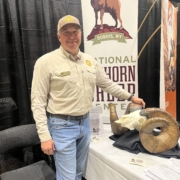History
The citizens of Dubois have always felt great pride for the proximity, accessibility, and successful endurance of “our” herd, the Whiskey Mountain herd of Rocky Mountain Bighorn Sheep. In the late 1980s, the Wyoming Game and Fish Department was considering building a small-scale sheep observatory with interpretive signage in the Whiskey Basin Wildlife Habitat Management Area. Around the same time, the Louisiana-Pacific lumber mill, which had been the primary engine driving the Dubois economy for decades, was faltering.
The mill was forced to close in 1988, leaving the townspeople to wonder if their economy was facing imminent failure. Dubois needed something to encourage tourists to stop and stay in Dubois. The Wyoming Game and Fish Department also wanted an avenue for public education. One citizen suggested the construction of a bighorn sheep-themed visitor center directly in town rather than in the Whiskey Basin Wildlife Habitat Management Area. In a rather remarkable effort of cooperation, a partnership developed that included a broad spectrum of private-sector and public-sector groups.
The Wyoming Game and Fish Department, the town of Dubois, the U.S. Forest Service, the Bureau of Land Management, the Wild Sheep Foundation (formerly the Foundation for North American Wild Sheep), the Nature Conservancy, the National Wildlife Federation, and many other entities and individuals contributed dollars, resources, talents, and guidance to construct the National Bighorn Sheep Center. The Center was opened to the public on July 3, 1993.













